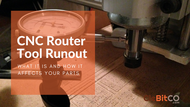CNC Router Tool Runout – What It Is and How It Affects Your Parts
Tool Runout
Runout is an error that makes a tool spin in an elliptical pattern rather than in a perfect circle.
Adjusting tool runout is necessary to maximize the life of your tools because runout can cause tools to chip prematurely, and impacts your cut quality. Plus, eliminating runout helps you achieve a repeatable result every time.
Radial Runout
Radial runout refers to how the tool deviates from a single axis in a rotational motion. Radial runout is visible in the feed lines that the side of your router bit cuts in your work piece. This type of runout is easily measured, and the term used to describe the deviation is T.I.R. (Total Indicated Runout).
For example, if you are using a 3-flute router bit and the T.I.R. measures .001, that means as the bit rotates, one of the cutting edges is going to cut slightly more than the others. This creates uneven wear on your router bit because one of the flutes is going to be doing more work than the other two, as opposed to all 3 flutes hitting the workpiece evenly. This also reduces your throughput, because your feed rates will have to be decreased to get the desired finish since one flute is hitting at the max deviation, which will show in more feed lines on your workpiece.
Not addressing radial runout can lead to poor cut quality and will decrease your tool life - costing you more money and increasing downtime to swap tools. Radial runout can also cause balance issues due to an imperfect rotational axis, causing weight to be unevenly distributed, which can lead to premature spindle bearing failure.

Axial Runout
The second type of runout, axial runout, refers to the deviation of a cutting tool from a straight line along its axis. It is a measure of the amount by which the cutting tool deviates from a perfectly straight line as it rotates. This means the face of your router bit is not parallel to the spindle face and can cause your CNC router to have errors in the dimensions it is cutting. Axial runout also causes poor finishes when slotting materials like acrylic, polycarbonate, PVC, polyethylene, ABS, nylon, etc. Since the bottom of your flutes are not evenly cutting, it will create drag lines or swirls on the bottom of your slot.
Now that we have defined both types of runout, let's talk about what to keep an eye out for and remedies.
What To Check
Here are a few common causes of runout and how to remedy them
-
Tool Holders and Collets
-
Check the condition of your toolholders and collet and ensure no visual wear, galling, or fretting
are present.
- Solution: Replace damaged tool holders and collets
-
On HSK63F holders, ensure that the spindle face is clean on the holder and your spindle. Since these
are dual contact - meaning the connection references the tool holder cone and the spindle face - any
particles jammed in between the two can cause runout.
- Solution: Properly maintain and keep your Tool Holders clean of dust and debris
-
Spindle Taper
- Check the runout of your spindle taper by putting an indicator on the taper and slowly rotating it
to check for movement of the indicator needle.
- Solution: Replace/repair spindle
Visually inspect your tool holder taper for damage, like this:

It’s a good idea to perform routine tool holder and collet maintenance to ensure everything is clean and not packed with dust which causes uneven clamping on the collet face.
Use a torque wrench, when possible, to tighten tools to ensure they are not distorting the collets and inducing runout.

Check out our Torque wrench category. Here you can find the correct torque depending on collet size needs. We also carry a wide variety of wrenches and collet key adapters to fit any toolholder, collet and nut combination you are using.
CleBitCo helps the Makers make, the Creators create, and the Doers do, and we can help you cut through it all - hardwoods, plywood, or softwoods. Plus, plastics like acrylics, polycarbonates, and polypropylene, and carving foam and rigid foam. With CleBitCo as your partner, you’ll be able to do more with your machines. Need some help with a project? Get in touch!
If you suspect your tool life is diminishing and your cut quality is decreasing, contact us and we will help you address the issue and remain productive.
(440)462-0619 sales@clebitco.comYou may also like
How to Prevent Hardwood Chipouts on Your CNC Router
How to Prevent Hardwood Chipouts on Your CNC Router Do you have problems with hardwoods chipping out on your CNC router? If you do, here are some solutions to the issue.It’s common, and we have encountered this many times, especially when routing 90-degree square corners. Chipout while cutting the perimeter to size on various hardwoods can [...]



